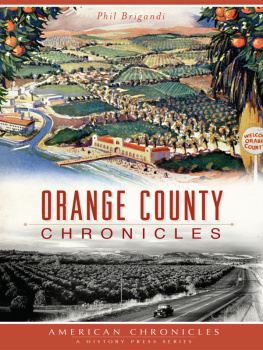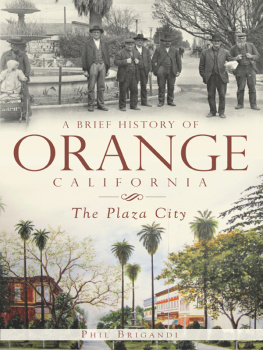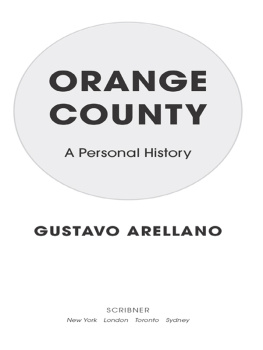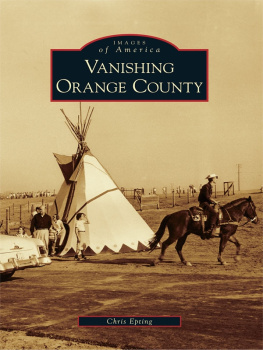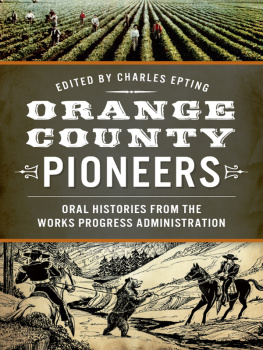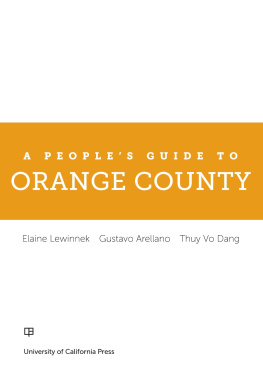
Published by The History Press
Charleston, SC 29403
www.historypress.net
Copyright 2013 by Phil Brigandi
All rights reserved
First published 2013
e-book edition 2013
ISBN 978.1.62584.588.7
Library of Congress CIP data applied for.
print edition ISBN 978.1.62619.133.4
Notice: The information in this book is true and complete to the best of our knowledge. It is offered without guarantee on the part of the author or The History Press. The author and The History Press disclaim all liability in connection with the use of this book.
All rights reserved. No part of this book may be reproduced or transmitted in any form whatsoever without prior written permission from the publisher except in the case of brief quotations embodied in critical articles and reviews.
CONTENTS
INTRODUCTION
Orange County is one of the best-knownand yet least understoodcounties in America. Too often, people who try to describe and dissect our county never seem to get beyond the glitzy image created by the media of Tuscan villas by the sea with waving palms outside and beautiful people inside.
But Orange County is much more than just the O.C. Its also the suburban neighborhoods of Orange, the barrios of Santa Ana, the townhouses of Brea, the apartments of Anaheim and the planned communities of Irvine. Its Little Saigon, Little Texas, Los Rios, La Palma, La Habra and Silverado Canyon. With a population of more than 3 million people, Orange County is a multifaceted, diverse and rapidly changing place.
One of the things missing from the many attempts to explain Orange County is an understanding of its past. Too many reporters, feature writers and even scholars dont seem to grasp that the roots of our countys identity run far deeper than the emergence of modern Orange County in the 1960s. I hope this book will help in some small way to fill that gap.
Of course, this is not a complete history of our county. That book will probably never be written. Instead, I have chosen to focus on a few important episodes and events that have influenced our history from the 1760s to the 1960s. These stories reflect many common themes in the history of this area including transportation, agriculture and the birth (and sometimes death) of communities. There are many, many other stories still waiting to be told.
Several of these stories have been published before in various forms (some more than once). The Birth of Orange County first appeared in Orange Countiana, the Orange County Historical Societys annual journal. The Stearns Ranchos and Breaking New Ground were previously published in the Branding Iron, the quarterly journal of the Los Angeles Corral of The Westerners. Others began as talks (or parts of talks) or various newspaper and magazine articles. All have been revised to a greater or lesser degree.
At its best, local history can help give all of us a sense of connection to the past, a sense of belonging and a sense of place. We are all part of a larger story.
Here are a few highlights.
THE MARCH OF PORTOL
Spain came to California with the cross and the sword. Together, Franciscan padres and Spanish soldiers worked to colonize the land and convert the Indians to Christianity. The King of Spain wanted to expand his far-flung empire. The padres sought to save souls. The cross came under the leadership of Father Junpero Serra. The sword was under the command of Captain Gaspar de Portol. In the spring of 1769, they established the first tentative Spanish outpost in California at San Diego.
Their next goal was the bay at Monterey. While Father Serra remained in San Diego to found Californias first mission, Portol gathered up about forty of his most trail-ready soldiers and set off north into a largely unknown land. Accompanying him were Lieutenant Pedro Fages in command of a group of Catalonian soldiers; Sergeant Jos Francisco Ortega, who would lead the scouting party; military engineer Miguel Costans; fifteen mission Indians from Baja California to help with livestock and supplies; and two gray-robed Franciscan Fathers: Juan Cresp and Francisco Gmez. Along with one hundred mules, the party stretched out over a quarter of a mile as it rode out from San Diego on July 14, 1769. (For many years, it was believed that Jos Antonio Yorbapatriarch of the famous Orange County ranchero familywas one of the Catalonian volunteers who accompanied Portol, but his name never appears in any records of the expedition. It seems that he came in 1771 with the first group of reinforcements.)
The Portol Expedition members were the first Spanish explorers to pass through what is now Orange County. They quite literally blazed the trail for much of the history that would follow in the next seventy-five years. Missions and ranchos grew up along their trail, and many of the place names they bestowed survive to this day.
We are fortunate that Portol, Costans and Cresp all kept daily journals of their trek. Father Cresps account is by far the most valuable, but for more than two centuries, it was primarily known through an abbreviated and heavily edited text. Then, after decades of research, historian Alan Brown identified the actual field draft covering the march north among the archives in Mexico City. It is the actual journal carried by Cresp along the trail. In 2001, Brown published it in translation, along with Cresps first revision of his journal, copied out soon after their return. While Portols route has long been known to historians, Cresps original journal adds a wealth of new detail about the land and the people they discovered along the way.
In the early 1900s, historians began to leave their desks and libraries and set out into the field, with the diaries of early explorers in hand, to attempt to establish the routes they traveled. The routes of Anza, Lewis and Clark and others were closely studied. In Orange County, the best fieldwork on the march of Portol was done by historian Don Meadows (18971994) beginning in the 1920s, when much of the area was still largely unchanged. The results of his researchfirst published in 1963are followed here.
By the time the Portol Expedition reached the edge what is now Orange County on July 22, 1769, the order of march was well established. Sergeant Ortega and a handful of soldiers rode ahead each day, scouting the trail. Portol and the main party followed, riding on mules, with the Indian vaqueros following behind, driving the pack mules. They carried supplies for five months on the trail. Their pace seems intolerably slow, but they were not just trying to cover ground. They were seeking a practical route north, clearing brush and cutting down banks at creek crossings. It was the beginning of El Camino Real.
A notable incident took place as the party reached the edge of Orange County. As the men set up camp on a little creek, the scouts reported that in the Indian village nearby, they had noticed a little baby who seemed close to death. Fathers Cresp and Gmez both went to look for the child.
They found the little girl in her mothers arms. We gave her to understand, as well as we could, that we did not wish to harm the child, Father Cresp wrote, only to wash its head with water, so that if it died it would go to Heaven. The mother allowed them to approach, and Father Gmez baptized the dying child. Learning that another little girl had been badly burned in a fire, they sought her out as well, and Father Cresp baptized her, giving her the name Margarita Magdalena. Their anxious desire to baptize these little girls reflected the padres belief that no one could enter heaven without the rites of the Holy Catholic Church. For them, saving souls was the whole purpose of the colonization of California, and these two little girls were the first to have the ancient rite performed over them. Costans calls the spot the
Next page
